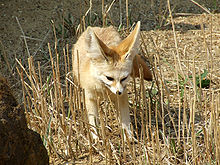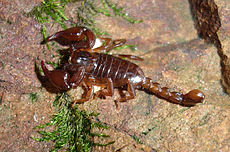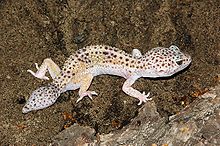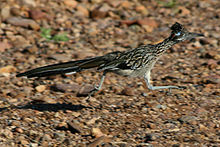- Xerocole
-
Xerocoles are animals adapted to live in a desert.
Under the scorching rays of sun, the arid and baked sands of deserts may appear to be devoid of animal life. But surprisingly a large number of animal species may thrive there. The animals are either drought evaders or drought resistors. Drought evaders make their appearance only when rain sets in, remaining dormant in the interim. All sorts of specialized animals, ranging from insects to mammals are found in a desert. Such animals are well adapted to desert life.
 The fennec fox is the smallest of all foxes, however it has the largest ears of any fox. These ears help not only in listening to tiny vibrations for hunting, but they also help it keep cool. Because the blood vessels in its ears are more exposed to the air, allowing the blood to be cooled down and then circulated around its body to help lower its body temperature in the hot desert.
The fennec fox is the smallest of all foxes, however it has the largest ears of any fox. These ears help not only in listening to tiny vibrations for hunting, but they also help it keep cool. Because the blood vessels in its ears are more exposed to the air, allowing the blood to be cooled down and then circulated around its body to help lower its body temperature in the hot desert.
- Surface grazer animals make use of water available from desert water holes and conserve it for long periods of time.
- Desert rabbits, tortoises, and wood rats (Neotoma) eat succulent plants for their water needs and do not drink water even if it becomes available.
- Jerboas, Kangaroo Rats (Dipodomys), pocket mice (Perognathus) and other desert rodents depend entirely on metabolic water produced in their body during oxidation of dry seeds and vegetation.
- Carnivorous animals get required water from the bodies of their prey.
- The skin of certain animals like sand lizards or Moloch horridus is hygroscopic and absorbs water like blotting paper.
Contents
Water Conservation
Xerocoles have developed numerous water conservation adaptations.
*To avoid water evaporation:
-
- The number of sweat glands are reduced or absent.
- Scorpions and reptiles have developed almost impermeable outer coverings.
- The thorny devil collect moisture in the dry desert via night-time condensation of dew which forms on the skin and is channelled to the mouth in hygroscopic grooves between its spines. During rain events, capillary action allows the lizard to suck in water from all over its body.
- Scales and spines are developed on the exposed surfaces of animals like sand lizards (such as Moloch horridus) and horned lizards.
- The carapaces of desert insects are waxy to prevent water from escaping.
- Camels can tolerate high temperature and can control loss of water through sweating. Water lost from their body is not from blood but from other tissues. They can lose 30% of their body weight without showing sign of distress.
- To avoid loss of moisture during evaporation:
- Many desert animals cool exhaled air in their noses before it is expelled out through nostrils. As a result moisture condenses in the nose and is not lost as water vapor.
- To avoid loss of water during excretion:
- This is brought about by excreting concentrated urine or urine in semisolid state. Desert rats and kangaroo rats excrete urine that contain 24% urea. The reptiles, insects, and birds excrete body waste in the form of uric acid and no water is lost.
Other methods of conserving water
Reptiles are more adapted to desert life then other animals, this is because they are ectothermic and need to keep their cold blood warm or else they will freeze to death. So they will often bask themselves in the sun, to help regulate their body temperature. Just like this leopard gecko as an example.
- Burrowing animals come out of their burrow in late night or early morning when moisture content in their burrow and outside atmosphere is almost equal. Some animals plug the mouth of their burrow during the day.
- Some desert animals, known as drought evaders, are active only for a brief period of the year when water and food is available. The period of inactivity is called estivation which is like the opposite of hibernation.
The Māori name for Rainbow Falls on the Kerikeri River is Waianiwaniwa which means Waters of the Rainbow. They are one of the most visited attractions in the district. It is possible to drive almost to the falls, with walking also possible from the Stone Store basin. The Māori name for Rainbow Falls on the Kerikeri River is Waianiwaniwa which means Waters of the Rainbow. They are one of the most visited attractions in the district. It is possible to drive almost to the falls, with walking also possible from the Stone Store basin.
Protection against scorching sun
- Xerocole animals possess a thick hide or protection armor of scales, spines, or dermal scutes.
- Long legs of desert animals lift their body above the ground to avoid direct contact of the body with burning sands.
- Large ears, such as the ones found on an african elephant help it cool down in places such as the sahara desert. Because the blood vessels in its ears are more exposed to the air, allowing the blood to be cooled down and then circulated around its body to help lower its body temperature in its hot environment. They can also be good for predators such as serval, in listening to tiny vibrations in the sand to pin point the exact location of their prey in the hidden grass or ground.
- Burrowing habits of animals, such as burrowing owls or prairie dogs help protect them from the scorching rays of the sun for a considerable period of time.
- Some desert animals have acclimatized to the high temperature of the desert. Beetles and lizards in general can tolerate temperatures much higher than can be tolerated by human beings.
Protection against sand storms
- Nostrils are either reduced to small pin holes or they are protected with complicated valves.
- Camels can close up their nostrils to keep sand out. And their long eyelashes help protect their eyes from blowing sands. However during sandstorms they will shut their eyes completely and can still see well enough through their thin eyelids to keep moving.
- In sandswimming lizards, the nostrils are directed upward; this may provide a protection from clogging by wind blown sands.
- In the lizard Mabuya, an enlarged transparent lower eyelid, or nictitating membrane, can cover the eyes thereby protecting them from sand without obstructing vision. In the lizard Ablepharus, the lower eyelid permanently covers the eyes and is fused with the lower margin of the eyelid. In camels the eyes are high on the head and are protected by long thick eyelashes.
- The ear openings of desert animals, if they exist, are either small, protected by fringes, scales or hairs.
Speed
Since desert animals have to move far and wide in search of food and water, the majority of them have great speed. The limbs are specialized and adapted to walk on sand.
- Limbs are often long.
- Desert cats paws have wide soles thickly covered with fur which enables them to walk comfortably even on hot sand.
- Legs of ostriches are padded with hair, muscular and developed.
- Camels have extra padding on the undersurface of their feet.
- Some lizards like Crotaphytus and Callisaurus have longer hind feet for fast running on sandy surfaces.
Categories:- Animal articles needing attention
- Deserts
Wikimedia Foundation. 2010.




